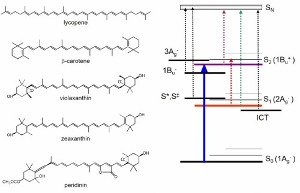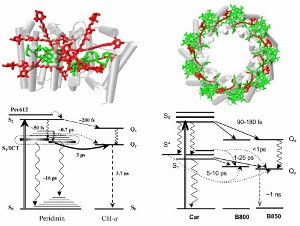One of the most important processes on Earth – photosynthesis – allows the conversion of the solar energy to the chemical energy that is further used by organisms including humans. Primary steps of the photosynthesis, such as photon absorption, are going inside the protein complexes named as light-harvesting antenna, and processing extremely fast – at the timescales from tens of femtoseconds (10-15 s) to tens of picoseconds (10-12 s). This processes are the subject of our studies in our laboratory utilizing state-of-the-art spectroscopic method (time-resolved spectroscopy). Understanding of these processes will make it possible the construction of the “molecular machine” that will convert solar energy to the reusable energy sources (e.g. molecular hydrogen).
Chlorophyll is not the only pigment that takes part in photosynthesis. All photosynthetic organisms contain carotenoids. Carotenoids are perhaps best known for their bright colors, they have well-documented multiple functions in nature. The diversity of carotenoid functions is unmatched by any other class of natural pigments and is directly related to their unique spectroscopic properties resulting from the structure of the carotenoid molecule. The spectroscopic properties of carotenoids, being fundamental constituents of light-harvesting complexes in marine algae, exhibit a strong dependence on the environment. Experiments carried out in our lab focus on disclosing the details of the excited states of carotenoids, along with their roles in relaxation pathways, and the relation between excited state dynamics and carotenoid structure.
• Polívka, T., Sundström, V. Ultrafast dynamics of carotenoid excited states. From solution to natural and artificial systems. Chem. Rev. 104, 2021-2072, 2004.
• Polívka, T., Sundström, V. Dark excited states of carotenoids: Consensus and controversy. Chem. Phys. Lett. 477, 1–11, 2009.
Photosynthetic apparatus of all photosynthetic organisms contains two vital components needed for the light reactions: a light-harvesting (LH) antenna and a reaction center. The LH complex absorbs light energy and funnels it into the reaction center where the charge separation takes place. Unlike reaction centers, LH complexes exhibit a large variability among photosynthetic organisms. In the majority of LH complexes, however, two types of pigments serve as light-capturing agents: (bacterio)chlorophylls [(B)Chls] and carotenoids. While LH processes carried out by (B)Chls are understood in great detail for many antenna proteins, the functions of carotenoids in LH complexes are much less understood, mainly due to their unique excited state properties. Nevertheless, there is conclusive evidence that carotenoids are capable of transferring energy to (B)Chls with efficiency ranging essentially from 0-100%. Reasons for such variability are not understood in detail, as well as the networks of energy transfer pathways. Besides, carotenoids also play a regulatory role in LH complexes by controlling energy flow throughout LH complexes. Consequently, the carotenoids’ actions in LH complexes are of vital importance for survival of photosynthetic organisms. The projects carried out in our laboratory aims for a deeper understanding of both LH and regulatory functions of carotenoids in antenna complexes from various photosynthetic organisms.
A number of other systems have been studied in our laboratory: xanthorhodopsin (Polívka et al. Biophys. J. 2009, Šlouf et al. Chem. Phys. Lett. 2011), orange carotenoid protein (Polívka et al. Biochemistry 2005, Chábera et al. BBA 2011, Polívka et al. 2013), Pcb complexes from Prochlorophytes (Durchan et al. J. Phys. Chem. B 2012), XLH from Xanthophytes (Durchan et al. J. Phys. Chem. B 2013), LH1 from purple bacteria (Šlouf et al. PNAS 2012), acpPC complex from Amphidinium (Polívka et al. Biochemistry 2006, Šlouf et al. Photosynth. Res. 2013).
• Polívka, T., Hiller, R. G., Frank, H. A. Spectroscopy of the Peridinin – Chlorophyll-a Protein: Insight into light-harvesting strategy of marine algae. Arch. Biochem. Biophys. 458, 111-120, 2007.
• Polívka, T., Frank, H. A. Molecular factors controlling photosynthetic light-harvesting by carotenoids. Acc. Chem. Res. 43, 1125–1134, 2010.
Not all pigments bound in protein are involved in light-harvesting and energy transfer. One of such examples, is the Orange Carotenoid Protein (OCP) found in cyanobacteria. In cyanobacteria, which are prokaryotes performing oxygenic photosynthesis, solar energy is absorbed by the large extramembrane complex, phycobillisome. Harvested energy is then transferred to photosystem II (PSII) and photosystem I (PSI). However, exposure of organisms to strong light can damage their photosynthetic apparatus, due to oxidative damage induced by excessive excitation. Cyanobacteria have developed a mechanism known as non-photochemical quenching (NPQ), protecting the PSII reaction centers by conversion of excess energy absorbed by phycobillisome to heat. This energy dissipation mechanism involves OCP. Upon illumination with blue-green light, it undergoes a transition from an inactive orange form (OCPo) to an active red form (OCPr). OCP and its evolutional precursor Helical Carotenoid Protein (HCP) present an ideal system to study carotenoid-protein interactions.
• Dominguez-Martin, M.A., Polívka, T., Sutter, M., Ferlez, B. Lechno-Yossef, S., Montgomery, B., Kerfeld, C. Structural and spectroscopic characterization of HCP2. BBA-Bioenergetics, 1860, 414-424, 2019.
• Šlouf, V., Kuznetsova, V., Fuciman, M., Bourcier de Carbon, C., Wilson, A., Kirilovsky, D., Polívka, T. Ultrafast spectroscopy tracks carotenoid configurations in the Orange and Red Carotenoid Proteins from cyanobacteria. Photosynth. Res. 131, 105, 2017.
Current grants
2019-2023 - Relation between structure and function of carotenoids: New pathways to answer unresolved questions, GAČR EXPRO 19-28323X
2018-2020 - Ultrafast spectroscopy as a tool for elucidation the structure-function relationship in cyanobacterial carotenoid-binding proteins, GAČR 18-21631S
Finished grants
2016-2018 - Carotenoids in light-harvesting and photoprotection – new approaches using multipulse femtosecond spectroscopy, GAČR 16-10417S
2012-2018 - Photosynthesis Research Center, GBP501/12/G055
2015-2017 - Understanding Hidden Charge Transfer States in Carotenoids by Multidimensional Stark Spectroscopy, MŠMT Kontakt II, LH15126
2011-2015 - Excitation energy transfer in pigment-protein complexes of microorganisms, GAČR GAP205/11/1164
2009-2012 - Excited-state processes in carbonyl-containing carotenoids and their roles in light-driven reactions in Nature, MŠMT - Kontakt, ME09037
• Radek Litvín, University of South Bohemia and Biology Centre of the Czech Academy of Sciences, Czech Republic
• David Bína, University of South Bohemia and Biology Centre of the Czech Academy of Sciences, Czech Republic
• Cheryl Kerfeld, Michigan State University, United States
• Alexander Ruban, Queen Mary University of London, England
• Roman Sobotka, Institute of Microbiology of the Czech Academy of Sciences, Czech Republic
• Radek Kaňa, Institute of Microbiology of the Czech Academy of Sciences, Czech Republic
• Eliška Kuthanová, Institute of Microbiology of the Czech Academy of Sciences, Czech Republic
• Miroslav Kloz, ELI Beamlines, Institute of Physics of the Czech Academy of Sciences, Czech Republic







